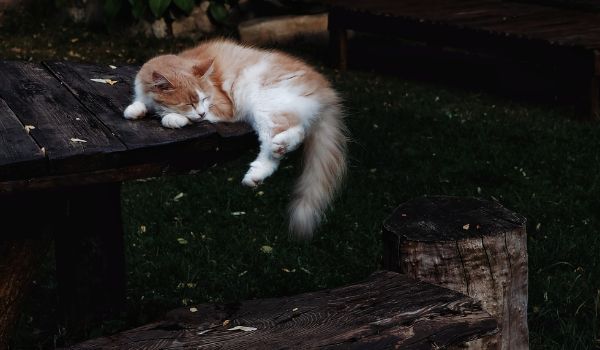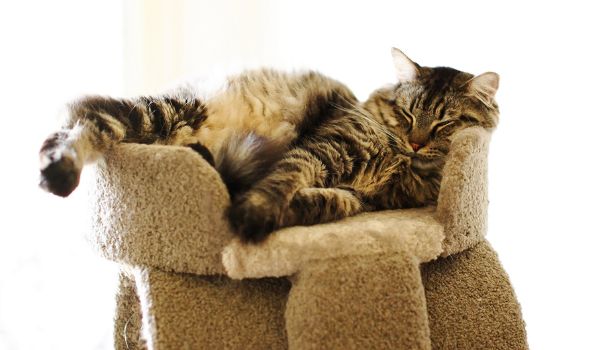Cats are super adorable creatures, and observing them going about their day is undoubtedly the favorite downtime activity of most pet parents. But even the mundane can sometimes work up these loving people. Questions like why cat tails move when they sleep can sometimes drive people to the point of absolute frustration.
It is indeed a seemingly harmless thing, but what if it points to a hitherto undetected, undiagnosed medical or psychological problem. Well, it may or may not be a cause for concern.
Read along to find out possible explanations for cat tail movement during sleep.
Why Do Cat Tails Move When They Sleep?
Cat tail movement is a regular feline behavior and could also be displayed as they sleep. It is important to understand that cat sleep pattern differs from human sleep pattern. They divide it into cat naps where they slump into a state of alert sleep, ready to jump back on a stimulus and deep sleep. With the former, you can observe them flicking their tail in a state of peacefulness or interest, mimicking their feelings just before they dosed off.
You can observe a movement with the latter as well, as the cat twitches in its sleep. It happens in REM sleep, where neurons blast signals to the brain, allowing it as much as a twitching movement. It could lead to slight movement in their tails as well. Besides, your ball of fluff could be enjoying a riveting chase in its dream (yes, cats do dream), acting out bits of it as the dream proceeds.
Unfortunately, the tail also could be moving due to an underlying medical issue. It could involve anything from a pest infestation or allergy to a more serious condition such as physical trauma (caused by accident), Hyperesthesia Syndrome, narcolepsy, or cataplexy.
Causes of Cat Tail Movement During Sleep
Now that you are familiar with the possible explanations for the feline tail quirks while it sleeps, let us explore these issues in more detail below.
1. Cat Nap
Ever observed a cat sleeping in odd positions, standing, sprawled over grass, or seemingly in the middle of some action? Well, that is a cat nap, and the source of the famous catnap terminology humans have adapted to refer to the quick power naps between work or during the day. A useful trait in the wild, it helped her take quick rest away from its predators yet allowed her to break into a sprint or strike back on stimulus, averting danger.

In this stage, you would notice the cat not only in the middle of some action but also mirroring her feelings before the nap. So, if you find a cat carelessly flicking her tail from side to side while napping, it means it was feeling peaceful or joyous before taking a break from its routine.
2. REM Sleep
Like their human counterparts, cats also experience the Rapid Eye Movement (REM) stage of sleep. Characterized by horizontal and vertical movement of the eyes associated with dreaming, it also involves temporary muscle atonia or paralysis. This prevents limb movement as the cat dreams.
But another feature characteristic of the REM sleep, frequent neurological messaging, could be responsible for cat twitching. Neural cells tend to send messages to the brain during this stage of sleep, recollecting events and contributing to memory development. This stage is particularly pronounced among the kittens, owing to their greater mental development requirements.
These cells perform the job by transferring signals from one neural cell to another in the form of a tiny current, referred to as blasting of the neurons, resulting in the slight twitching movements of the feline. This movement consequently results in what humans recognize as a slight tail movement.
3. Acting Out Their Dream
We have mentioned that, like humans, cats experience muscle atonia while sleeping and would therefore be prevented from movement. However, the REM sleep is indeed interspersed with fine motor movements, where your cat could be slightly acting out her dream, leading to some limb and tail movement.
Another explanation for a more vigorous movement could be that all dreaming does not happen during the REM stage of sleep. Cats can also dream during non-REM sleep, associated with sleepwalking or sleep talking in humans. Your beloved cat could be engaged in an exciting mouse-hunt in its dream while you bear witness to her fantasies, watching it swish its tail before pouncing upon its scared prey.
4. Physical Injury/ Ill Health
Unfortunately, a cat may be moving her tail in her sleep owing to an underlying medical condition. While some of the conditions could be afflicting the entire body, some of them seem to afflict their posterior regions. It is not to suggest that tail movement due to a medical condition is restricted to sleep alone; it is only that owners may have had a chance to observe the symptoms during sleep.
Cats can move their tails due to a pest infestation, such as that of fleas or another allergic reaction afflicting their body. Here, the tail may be moving in reaction to or to ease the itching sensation. Other possible reasons could be localized (posterior end) muscle trembling, epilepsy, the feline hyperesthesia syndrome, or a physical injury of the tail.
However, conditions like narcolepsy or cataplexy, both sleep disorders, can mess up the brain circuitry involved in controlling limb movement during sleep. As a result of these conditions, the movement uncharacteristic of a sleeping cat could be observed and may involve tail movement.
What to Do When Cats Move Their Tails in Their Sleep?
Leave them alone. Disturbing a cat from her sleep can have negative consequences for both the feline and yourself. Look for symptoms, notice if it looks fine while it moves the tail, or do you notice signs of discomfort on her face/ body. Does it seem lethargic or sleepy during the day?
Maintaining good hygiene and checking for pests from time to time is a good practice for pet maintenance. Carefully approach if it seems injured and only proceed if it allows you to; otherwise, a trip to the vet is advised.
And if it appears that what you deemed a movement during actually an episode of epilepsy, narcolepsy, tremors, or a similar condition, take your first possible chance of getting a thorough examination from the vet. By all means, stay away from a cat undergoing seizures, as not only will it make involuntary movements that could harm you, but your touch could multiply their pain as well.
Final Word: Why Do Cat Tails Move When They Sleep?
Cats moving their tails while sleeping is a regular feline behavior during cat naps, REM sleep, and to an extent dreaming. The neurological motion forcing the movement during REM sleep facilitates motor skills and memory development. But the medical causes need immediate veterinary attention.


